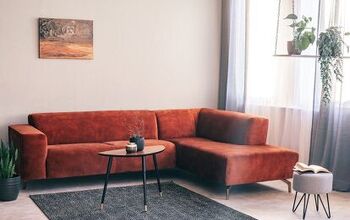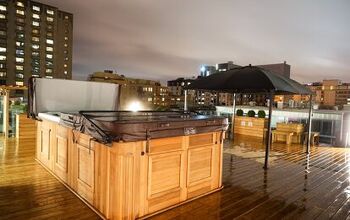Can You Put A Couch In Front Of A Radiator? (Find Out Now!)

For many years, radiators were standard equipment for heating homes. Radiators seemed to fall out of favor with the advent of a central HVAC system. However the advent of new technologies and more efficient designs, radiators seem to be making a comeback. Many people moving into homes with radiators often wonder if they can put a couch in front of a radiator.
It is generally not a good idea to place a couch or any other furniture directly in front of a radiator. The need for unhampered airflow around a radiator for effective and efficient heating is one reason. If no other options are available, you can place a couch in front of a radiator if the proper precautions are taken.
Radiators can make decorating your home more of a challenge. The need to leave the areas around a radiator unobstructed can limit the possibilities for placing furniture. Understanding how radiators work can make your choices a bit easier. Thinking a little outside the box when placing furniture can also help.
Do You Need a Heating and Cooling Contractor?
Get free, zero-commitment quotes from pro contractors near you.

Radiators and Heat
New radiators are efficient and effective ways to heat a home. New technologies have made the use of radiators more acceptable to many homeowners. The concepts of radiators are almost as old as heating itself.
Most radiator systems work by circulating hot water from a central boiler to the radiators around the home. As air circulates around the radiator, the heat is transferred to the room air. The cooled water circulates back to the boiler.
Most radiators don’t have fans and depend on natural air circulation to spread warm air through the room. As the air around the radiator is heated, it rises. Coller air is drawn around the radiator. This circulation creates movement of air in the room that provides an efficient means of warming the space.
Air Circulation is the Key
Having a free flow of air around the radiator is the key to heating the space. If anything impedes the circulation of air around the radiator, the room will not heat effectively. This can cause problems with comfort as well as with your heating system.
Inadequate airflow around the radiator can leave your room with cold spots. This can be especially troublesome in larger rooms or rooms with tall ceilings.
In addition, if the radiator doesn’t have adequate airflow, it cannot effectively transfer the heat from the hot water. If cooler water is not circulated back to the boiler, the entire system may not operate as efficiently to warm your home.
Placing Furniture and Drapes Over and Around a Radiator
For some reason, a popular place for radiators is in front of a window or on a long wall. This placement of the radiator creates some unique challenges when decorating a room. Unfortunately, you can’t simply move a radiator to a new location. You must make adjustments and allowances in your decorating scheme.
Avoid Long Drapes that Cover a Radiator
Radiators placed under a window can be awkward when selecting and installing drapery. You should avoid long drapes that cover the radiator. Even drapes that hang a few inches above the radiator can cause air circulation problems
Furniture Locations
Radiators seem to almost always be in the wrong spot. If the radiator is on a long wall, it may be in exactly the space you need to place a couch. On short walls, a radiator can preclude putting any furniture of any size on the wall.
The problem is, again, air circulation. A couch snuggled up to a radiator can effectively prevent any air circulation. This can cause the room to stay cold and the radiator to stay hot. The key to locating furniture in a room with a radiator is to maintain enough distance from the furniture and the radiator to not prevent air circulation.
When All Else Fails, Keep the Minimum Distance
If you must place a couch or other furniture in front of a radiator, you must keep a minimum distance to make air circulation possible. In most cases, you should keep the couch or other furniture at least one foot away from the radiator.
A minimum of one-foot separation from the back of the couch to the radiator should allow enough air circulation for the radiator to work effectively. This may not be the most efficient radiator and boiler operation, but it will allow you some flexibility in placing furniture.
What Other Problems Can Occur from Placing a Couch in Front of a Radiator?
Placing a couch or any other piece of furniture in front of a radiator not only impacts the radiator’s efficiency but can also be damaging to your furniture. The heat from the radiator can affect your furniture in several ways.
- The high heat from the radiator can damage fabrics easily. Prolonged exposure to the heat of the radiator can cause some fabrics to melt. Other fabrics may discolor or fade. You may even notice that the fabric begins to become brittle.
- Exposing wooden furniture to a radiator’s heat can cause many problems. The wood of the furniture may begin to dry out and crack. Glue joints may weaken, leaving furniture joints open or loose. The finishes on the wood surfaces may be yellow or discolored. In some cases, the finish may bubble, flake or peel.
- A couch too close to a radiator is an invitation to injuries. Most radiators get hot enough to cause minor burns when touched with bare skin. A couch in front of a radiator can open the chances of someone accidentally laying an arm on the radiator, not realizing the danger.
- A radiator behind a couch or next to a chair can become a handy place to put a plastic glass or another container. A plastic soda bottle placed on a cool radiator may become a molten blob of hot plastic when the radiator comes on.
These are just some of the scenarios you want to avoid by placing the furniture or drapery too close to a radiator. Safety should be a primary goal when arranging furniture in a room with a radiator.
Do You Need a Heating and Cooling Contractor?
Get free, zero-commitment quotes from pro contractors near you.

Placing Couches In Rooms With Radiators
Decorating in rooms with radiators can pose challenges. However, with a little ingenuity and imagination, these hurdles can be overcome. The primary goal is to allow the radiator to perform its job efficiently and effectively by not compromising the air circulation.

Dennis is a retired firefighter with an extensive background in construction, home improvement, and remodeling. He worked in the trades part-time while serving as an active firefighter. On his retirement, he started a remodeling and home repair business, which he ran for several years.
More by Dennis Howard




















![10 Most Dangerous Neighborhoods in Baltimore [Updated]](https://cdn-fastly.upgradedhome.com/media/2023/07/31/9075655/10-most-dangerous-neighborhoods-in-baltimore-updated.jpg?size=350x220)






